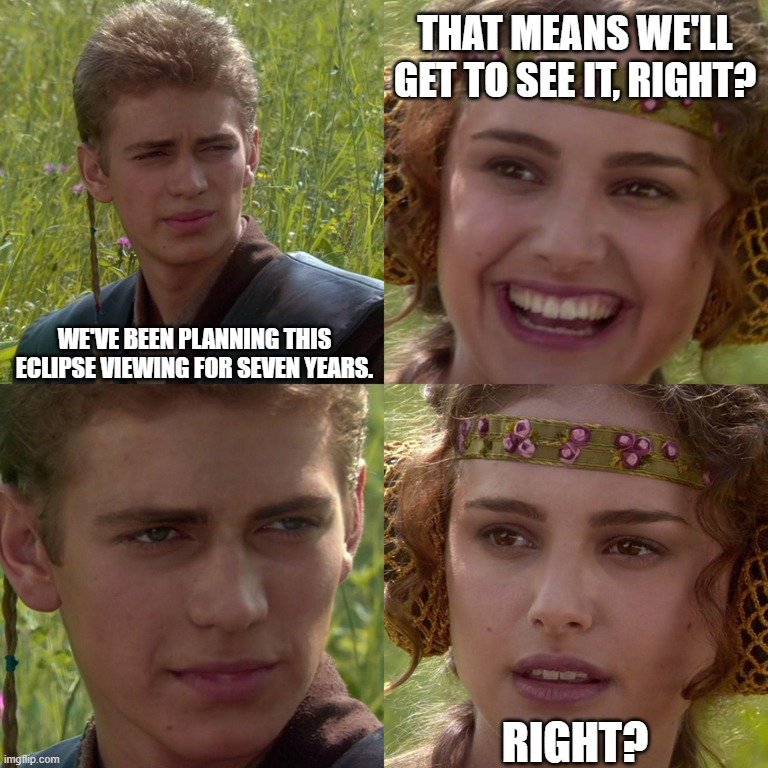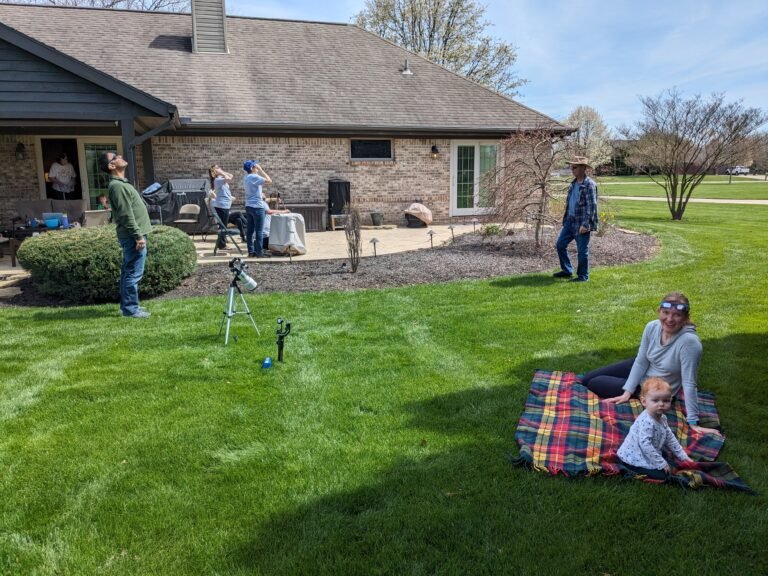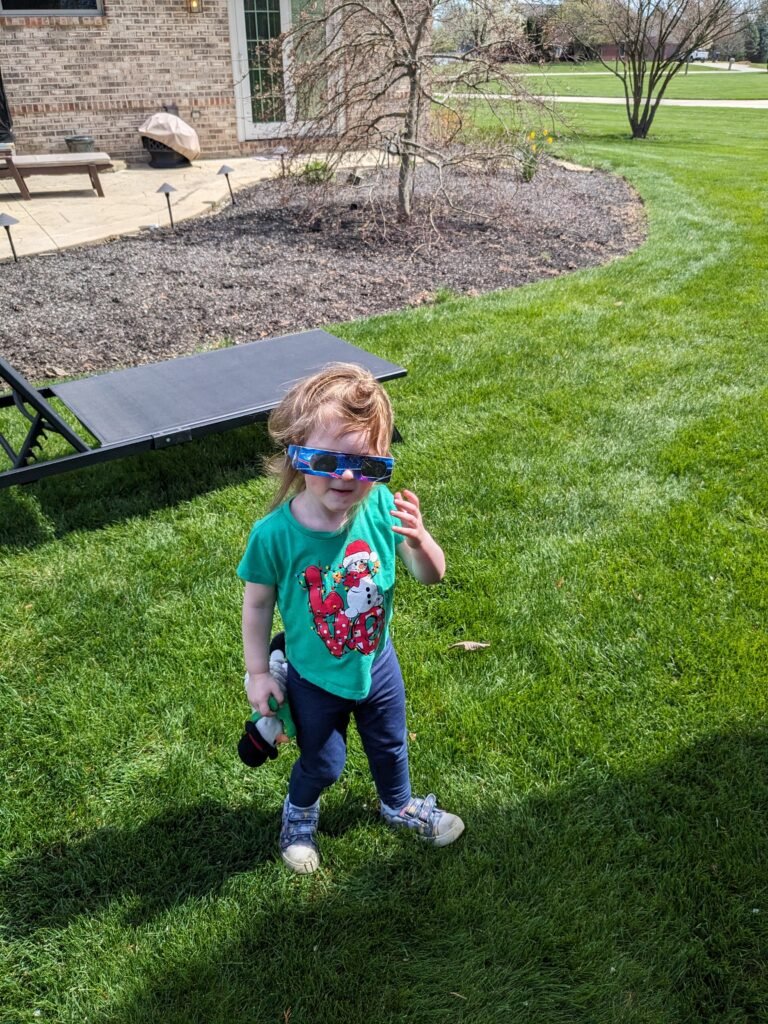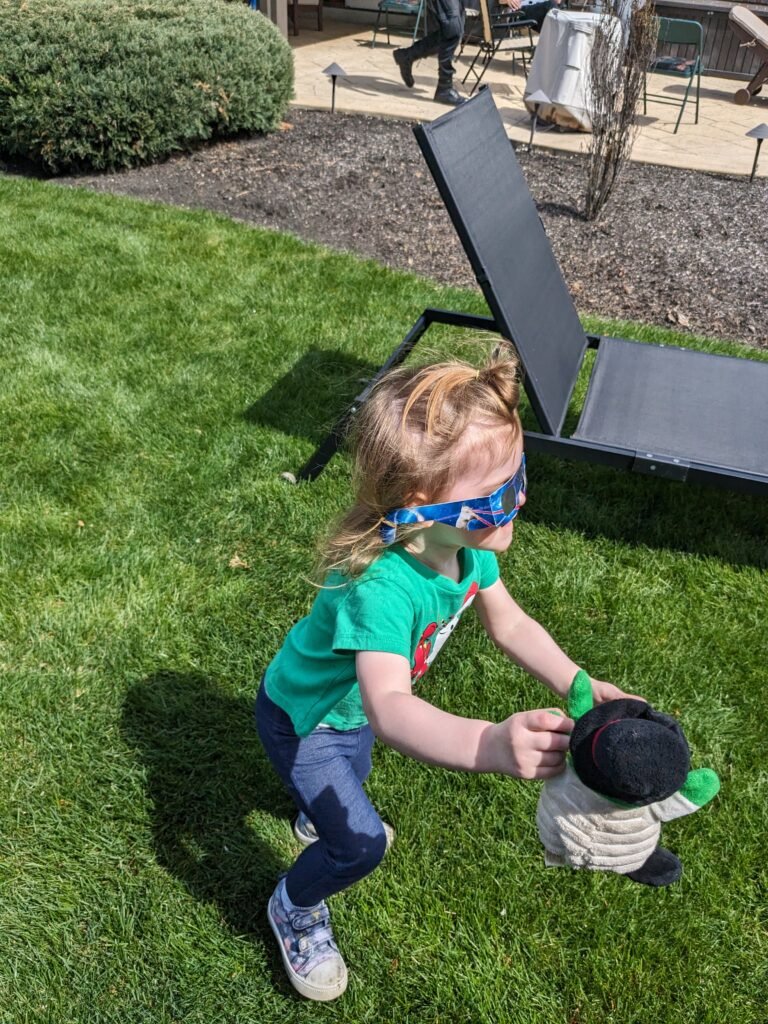
The Great North American Eclipse
On 21 August 2017, around 2:30 in the afternoon, I sat in a baking parking lot at The Ohio State University. It was a Monday, and my wife had emerged from the Mathematics Tower to join me during a break between teaching classes. Wispy clouds hung in the sky but did not diminish the brightness of the Sun. Divorced from context, it was a hot but pleasant day.
Approximately 280 miles to the southwest, humans in Kentucky and Tennessee experienced a completely different scene. On this Monday, the Great American Eclipse unfurled along a narrow band that stretched from Oregon to South Carolina. The Moon’s disc ambled in front of the Sun, casting a profoundly dark shadow along this corridor. As I sat in a concrete lot, people two states south intersected with a magical 160-second stretch, in which day became night.
Compatriots of ours were near Carbondale, Illinois, waiting for the post-event traffic jam to ease. Their magical period had just concluded, with clear skies providing a dazzling couple of minutes of totality. Later, Alan R. penned a wonderful essay for this project on the science behind the rarity of total solar eclipses and a firsthand account of the awe they produce.
In the piece, he highlighted the popular misconception revolving around percentages of totality. Along the shadow’s band, the Moon obscures all of the Sun. Outside but near the band, the Moon covers a percentage of the Sun’s disc, producing a partial eclipse. Though the mathematics of the coverage is technically true, in effect, there is no such thing as 90% totality, 99% totality, or even 99.9% totality. The Sun is so blindingly bright that 99.9% of totality still produces daylight to human eyes. Total solar eclipses are binary; you are either in totality or not. Through a solar filter, the Moon covering 99.9% of the Sun will look rather striking, but take off the glasses and one won’t see the Moon at all, just strident sunshine.
Those unfortunate souls who cannot witness totality often cope by pointing to the percentage of totality they witness. In Columbus, I told myself how amazing it was to be in a spot that reached approximately 86% coverage. In reality, I was about to discover that 86% of zero was zero. The 2017 event was notorious for a lack of eclipse-glasses supply. If one had not purchased the eyewear far in advance, one was out of luck. Knowing we would not witness totality, my wife and I had not acquired glasses early enough. As normal campus activity buzzed around us, we waited for a darkening sky that would never arrive, without the ability to view the 86-percent Moon crescent transpiring above. We attempted a few tricks of photography and shadows, but the results were noticeably subpar.
I attempted to imagine being in the path of totality. I felt I could not intrinsically conceive the experience. Alan wrote of a conversation he had with a local astronomy club president, who said, “Whenever I ask someone if they’ve seen a Total Eclipse in person, and they say they don’t know, then they haven’t. You don’t ever forget it.” Though I could not envision the experience, I could deeply feel the lack: I knew I had missed something transformative. My wife’s teaching schedule had precluded us from traveling for the eclipse; we didn’t have glasses. We weren’t in the One, we were in the Zero.
As the Sun continued to beat on us, I vowed I would not miss the next total eclipse, which would occur in 2024. I would do everything in my power to put myself in a position to experience the wonders of syzygy.




Seven years is a tricky amount of time. It’s close enough to feel touchable but long enough to seem unplannable. Sure, one can brainstorm scenarios, but too much life can transpire in such a period to make any potential a lock. The best I could do was mentally check in every so often as the years passed.
This approach proved to be wise, if at least by accident. In 2021, our family became three, before that number grew to four in 2023. Traveling parents know the particular stresses and roadblocks that children bring. In the back of my mind, each time I would ponder the eclipse, I began to worry about the inclusion of my daughters. One image I conjured after 2017 was that of the eclipse-viewer-as-storm chaser. I pictured roving across North America as freely as possible, in search of the the spot that would guarantee clear skies for totality. With two daughters in tow, this freedom would be nearly impossible at worst, and highly foolish at best. Further, I had no intention of ditching them, either. Though I badly wanted to see the eclipse in 2017, I wanted to see it with my wife. Leaving her to 86% while I galavanted around the shadowverse did not appeal to me in any way. Though my children might not recall seeing the event, thanks to infantile amnesia, viewing it without them would feel like a husk of the shared experience.
While the kiddos would provide an extra challenge, a few things conspired to make the 2024 eclipse more manageable. Unlike the capitalistic failure of 2017, businesses rose to the test, producing an ample amount of eclipse glasses. I made sure our family had more than enough in plenty of time. More importantly, this iteration would pass much more closely to home than 2017’s eclipse. If we wanted, we could spy a few seconds of totality within a short drive, or a few minutes from the same parking lot we used in 2017. Spots in the middle of the totality swath, which provide the most time in darkness, were within an hour’s drive. This convenience seemed to be divine intervention, as I pondered having to travel spontaneously with my children on the day of the main event.
The proximity of the eclipse brought even better news. Smack dab in the heart of the path was the abode of the man who implored us not to miss the next opportunity in his article on the 2017 eclipse: Alan R. He relished the chance to step into his yard to witness one of the greatest natural phenomena on Earth, and he graciously extended an invitation for our family to join him. With a plethora of variables to consider, having a first-choice location set made things a lot easier.
The downside came with the date. The Moon would cross paths with the Sun on 8 April 2024. Spring in the Midwest is not famous for bringing clear skies. As the years turned from 2010s to 2020s and internet bluster for 2024 grew, one chorus rang out louder than anything else from all the professional prognosticators online. It was a joke rooted in reality. Q: what are the chances of rain or completely cloudy skies in Ohio in April? A: 100%. This statement obviously is not a certainty, as plenty of fantastic weather days transpire in April, but, as T.S. Eliot famously opined, April is the cruellest month.
The weather would be a serious concern.
About a year before E-Day, I started to seriously ponder the path of the shadow. The best-case scenario involved a relatively stress-free trip to West-Central Ohio, but what if the heavens did not play well? The eclipse would begin in Mexico, before hitting the United States in Texas. From there, the event would spread northeast, eventually moving to Maine and exiting through Canada. The best long-term probabilities for good viewing belonged to Mexico and Texas. (Aside: the path put Maine’s High Point, Katahdin, in totality. I could not imagine a better spot to view it; however, climbing the mountain in April is forbidden to preserve the ecosystem during the muddy season.) South of the border seemed too expensive and logistically unfeasible. Texas, however, could be doable. I had just ventured to southeastern New Mexico and the tip of Texas with one child and a pregnant wife. Still, I scuttled this excursion to the back of my mind and labeled it a “doomsday scenario.”
As time moved forward, this type of planning started to take a toll on my psyche, both positively and negatively. On one hand, foresight was necessary, as hundreds of thousands or millions of people were plotting their experiences. Those outside the totality band would likely want to give themselves the best shot at seeing the eclipse. To avoid being frozen out, bookings happened a year or more in advance at many prime lodging sites. Spontaneity and mobility would be key allies for the successful eclipse hunter, but still required an operational base. Designing scenarios helped ease the what-ifs for the big day. However, the huge number of possibilities also started to create option paralysis. Where would be the best place, should the need arise? What would we do if the weather in Ohio and Texas was terrible?
Until this point, I had not seriously considered the potential to miss the eclipse. Seven years of planning would certainly lead to triumph, right? Right?


A future disaster took root in my mind, especially after October 2023. If you read Alan’s article, you know a tasty ecliptic appetizer lay just half a year before April 2024. The Western United States would be treated to an annular eclipse, also known as a ring of fire. In this scenario, the Moon is in the right spot to produce a total eclipse but is too far away to completely block our star. This situation produces a spectacular, fiery circle around the dark Moon. I had also not witnessed an annular eclipse, so we planned to make a pilgrimage to watch 2023’s version.
For largely logistical reasons, this adventure did not transpire. Though I realize many greater tragedies exist in life, I was devastated by missing this phenomenon. The ring stung, but its true effect was to crystallize the prospect of missing the total eclipse in 2024. I developed a major Fear Of Missing Out Nature Version, which I examined just a couple of months before April.
I grappled with the notion that I could have planned and controlled all I could, yet still emerge heartbroken.
As April neared, I began to pore over weather histories. What percentage of April days were completely cloudy or rainy in Location X? As the first long-term forecasts rolled in, I joined other obsessives on the internet, comparing one model against another. These computer simulations can miss wildly when the timeframe stretches weeks, but they were something tangible to study, which helped ease (and fuel) anxieties. Most of the models predicted what we had thought for many months: Texas good, Midwest bad. Spots between Texas and the Lower Midwest looked OK. New England? One might as well watch a feed from Texas.
Things did not look promising.
A week out, a few curious things occurred in algorithm-land. Texas continued with clear prognostications, but a corridor opened in New York and New England of predicted cloudless skies. Many people started to audible to these regions, at least as a backup. We did not ever seriously consider these spots, but the change in forecast did give me hope that the skies in Ohio might also clear. The most interesting aspect, however, arrived in a comparison of the models. Most of the programs concurred on the likely pall of clouds over the Midwest. One rogue program, however, dared to dream. The Canadian Clouds Forecast For Astronomical Purposes portended clear skies in Ohio and Indiana. I refreshed the screen dozens of times, looking for a correction to a glitch. Instead, it continued to promote blue. What was causing this lone dissenter? I had no idea, but it allowed me to hope.
I had invited some of my family to join us at Alan’s house, which arrived with a few caveats. I wanted as many people as possible to view the eclipse, as I truly believed it would be a transcendent experience for everyone. However, I knew most would view my car-ready mobilization as the musings of a roving obsessive. Few people would want to hole up in a vehicle, ready to drive hours to pull off on the side of the road somewhere, just in the hopes of getting clear skies. And I completely understand that viewpoint. Many did not have the flexibility to drive much from their places of employment. Schools and businesses provided half and full days off, but not to everyone. I attempted to give as much info as I could to as many people, even if they did not join me. I convinced my mother to travel with us, though I sensed she was uneasy about the potential to drive around the Midwest, should the need arise.
On the eve of the eclipse, we decided to make Alan’s house our center for operations. We deemed the chances of favorable conditions high enough that driving a few hours in any direction from there to be a decent strategy. Texas and New England were out. We would hang our eclipse hats on the Midwest. I prepared for the worst.

We loaded the car with as many necessities as we could imagine. Food, clothing, toys, and diapers for the kids. Nourishment enough to power a family through any potential traffic jams we might meet after stopping on a random road in Indiana. Video gear to document the eclipse. Computers for real-time analysis of the weather, even on the go. Phone apps were purchased to help time each portion of the eclipse. I felt the crush of seven years of anticipation, but I felt I had prepared all I could.
I stepped out into the early morning of April 8 to a glorious sight: not a single cloud in the sky. Yes, this blue glance was many hours before the eclipse, so things could easily change. I had expected, though, to emerge to an overcast middle finger from the cosmos. Excitement intensified!

As we drove toward the Dayton area, the blueness continued to dominate the sky, though a few cirrus clouds began to emerge. Was it possible we would be able to go to our center of operations and remain there? Was Ohio going to provide a day of immutable beauty in the middle of April?
Despite arriving many hours early, we moved quickly to set up computers, cameras, and a telescope. Though we had gathered for the several minutes of totality, everyone was excited to don glasses as soon as the first hint of eclipse began (or even before!). For the first time, regarding the 2024 event, I started to relax. Each emphatic refresh of the weather sites showed an unbelievable amount of clearness in our region. I had all the gadgets I wanted, ready to snag some wonderful footage. I could not believe how well things were sliding into metaphorical and literal syzygy.
The Moon began to creep across the Sun’s disc. With glasses on, we caught our first glimpse of black sliver. For the next hour, the small group of family and friends fraternized and speculated, growing more excited by the minute. I never strayed from the computer, though, keenly watching for a last-minute trick of the heavens. As we approached totality, it truly appeared as if the weather would hold. The temperature noticeably dropped and things began to get darker. I could not recall having experienced these attributes in 2017, but perhaps we were simply too far from 100%. This thing was really going to happen!
The past seven years faded into obscurity. I was about to share one of my life’s natural goals with my family and friends at my side. Now, we just had to wait for the Moon to finish her work.



At this point in the tale, one might reasonably conclude the eclipse proceeded without issue.
When it comes to the Sun, the Moon, and the clouds, they played their parts perfectly. On the ground, things did not go as smoothly as I had hoped. My dream scenario was to film and photograph the eclipse from both a wide and close view, have a telescope pointed at the Sun for my daughters, in particular, to view, and spend ample time marveling at the cosmos next to the people who matter most in my life. I was a fool to think I could help wrangle a nearly three-year-old and a one-year-old, while getting them to look through a tiny hole without moving the apparatus, all while attempting to snap photos and garner handheld video. In the wide-angle video I captured, you can see me moving around erratically, attempting to juggle too many balls at once. I make a joke to my mother about not texting during the once-in-a-lifetime eclipse, but it comes off sounding like a criticism. She called my attention to a phenomenon known as shadow bands that she and the others on the concrete nearby could see, but I was so wrapt up in my technological head that I didn’t go to investigate. I was clearly stressed, especially during totality when the telescope experiment turned into a silent-film-era gag. In retrospect, I should have set up the wide-angle camera and relished every second of the three-minute spectacle with my family. The rarity of the eclipse pushed me to document it, but the documentation caused me to miss precious portions of the happening.
Even with this tension, the eclipse was incredible beyond words. When I took my glasses off, my eyes beheld a universe they had never experienced. A diamond ring shimmered as the Moon overtook the Sun. The white corona danced around the black disk, as ruby-colored solar prominences leaped from the bottom. In a complete circle around the horizon, twilight dominated; the Sun was setting everywhere at once. Venus emerged below the Sun. Stars were visible during the day. I stared at the scene, but my mind could not process what it was seeing.
It’s been four and a half months since April 8 and I’m no closer to processing the imagery.
Beforehand, Alan and many others cautioned that photographs did not come close to translating what one sees in person. I can now completely corroborate this statement. The corona’s flickering does not come through on any photo or video I have witnessed. Still images of the black disc and the corona are marvels, and some of them approximate a blink of the phenomenon, but nothing seems to mimic the amorphous vitality of the firsthand experience. The Sun was alive, wriggling around a dead disk.
Perhaps the harshest aspect was the time limit. In the realm of total eclipses, the three minutes we experienced is a high amount. Yet it felt as if it ended in 30 seconds. I instantly understood why some people decide to chase eclipse after eclipse. What I had seen was ineffably gorgeous, but it was too short.
Thankfully, the wide-angle footage I managed to snag became a wonderful document. It does not display a close-up of the corona, but it captures what happens to the surrounding environment perfectly. The darkness, the changing colors, the movement of light, the contrast, the crowing chickens afterward.

Further, it gives me a memory of the people around me. As I sat with my wife and daughters, with my mother feet away, with some incredible friends, I realized I had made the correct decision in 2017 not to travel to that eclipse alone. Experiencing this rarity with loved ones was just as phenomenal as the phenomenon in the sky. This video shows the jitters, the excitement, the conversation, the awe, and the companionship we all shared. One day, perhaps sooner than I wish, some of the people in the video might not be around anymore. I feel blessed to have intersected with them that day. What a sight we beheld together!
All the anxieties and regrets from the previous seven years melted. Everything had been worth those three minutes. Each time I think about that day, I well up with a mixture of joy and something approaching profound sadness. The melancholy of something great now being in the past. This sadness, though palpable now, really lives in the future. When I conjure the eclipse in the future, I will see my young daughters, my wife, my mother, and dear friends, as we gather on a green to watch one of the universe’s greatest spectacles. How fortunate we were to be there. How many people across the eons had never traveled to the band of totality? How many had been in the right spot, only to miss the sight due to poor weather?
Many humans never get to witness this splendor. If you ever have the chance, please grab the opportunity.
Now, I have some planning to do. There’s a total eclipse in 2026. What do you think, Spain or Iceland? Oh, and God bless the Canadian Model!
Further Reading and Exploration
Live Broadcast of Total Solar Eclipse – NASA
Total solar eclipse of April 8, 2024 over Mexico, the USA, and Canada – Great American Eclipse
The Total Solar Eclipse Experience: An Observer’s Viewpoint – Alan R. for The Mountains Are Calling
Nature FOMO – The Mountains Are Calling











